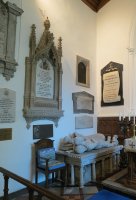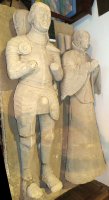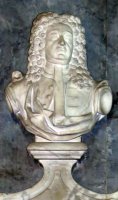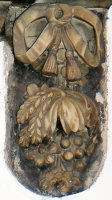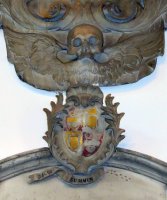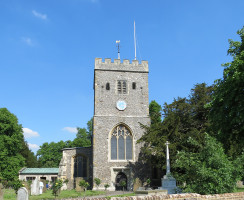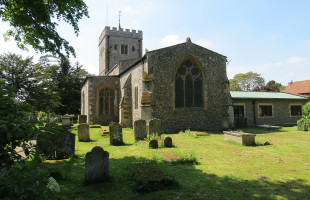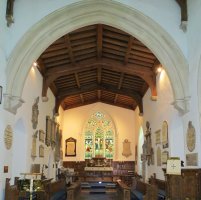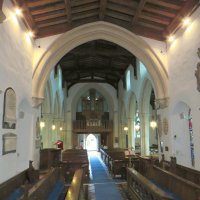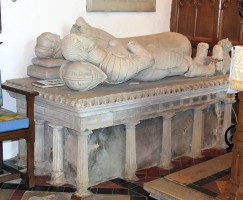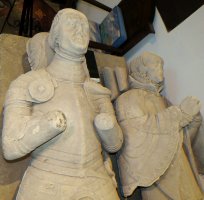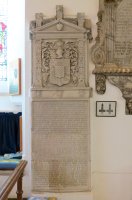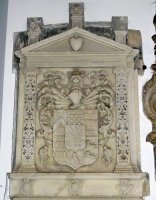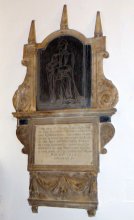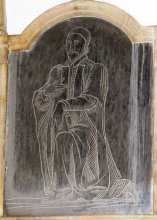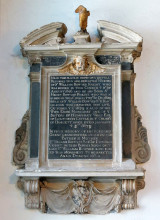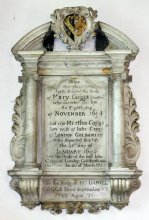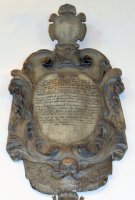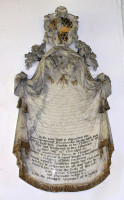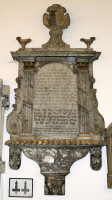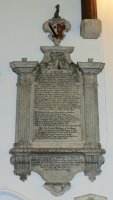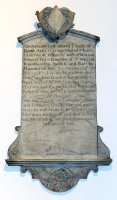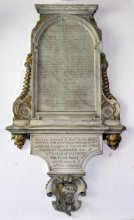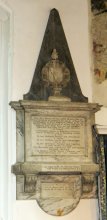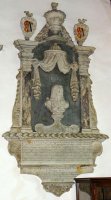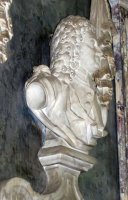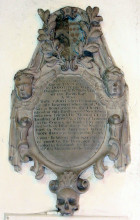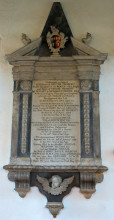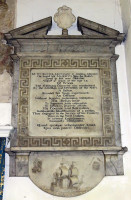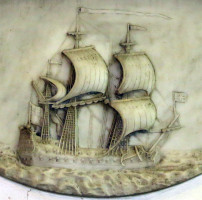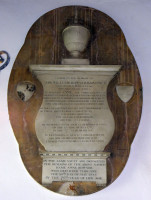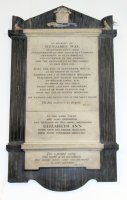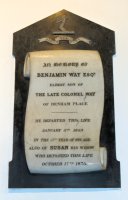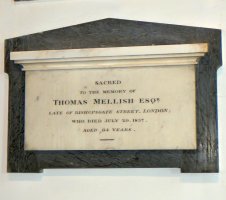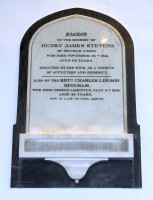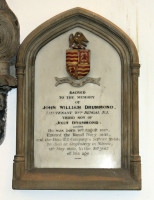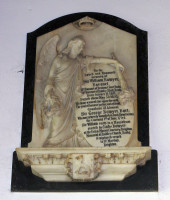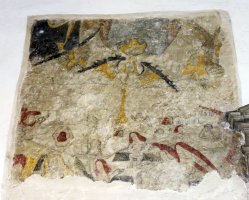Monuments in Denham Church, Buckinghamshire, near Uxbridge, West London
Denham, just inside South Buckinghamshire, is a short bus ride from Uxbridge on the Metropolitan Line, and the church there is well populated by monuments. The church was rebuilt in the 15th Century, and the first monument, the grand tomb of Sir Edmand Peckham and his wife, dates from the late 16th Century; the collection is particularly strong in ornate 18th Century wall panels of various types, and has also a number of simple white-on-black 19th Century pieces.
The Parish Church of St Mary is faced in flint and with dressings of pale stone and built in Perpendicular Gothic style, as its main exterior feature a low, square battlemented tower. This tower, nave and aisles all date from around 1460, mostly intact with various additions and restorations, especially around the windows, subsequently, and a modern excrescence. The chancel though, is of the 14th Century, being the earliest surviving part of the church, built in the 12th Century. The nave and chancel extend for some considerable length for what is a fairly small church.
Inside, the Church is long, narrow and high-roofed, with enough oak furnishings to give a historic atmosphere, though the walls are whitewashed. Wall plaque monuments are scattered around the walls, with a particularly good selection nearer to the altar, where stands also a grand altar tomb with two recumbent figures.
Interior views through Chancel arch.
The Church s history is that after the Dissolution of the monasteries, Denham, with its great house Denham Place and its church as well, were granted to Sir Edmund Peckham, MP for Bucks, but the family came into debt, and in 1596 the Crown passed the estate to William Bowyer, and thence by descent to a certain Roger Hill and eventually to Abigail Lockey, and by marriage of her daughter, also Abigail, to her husband Lewis Way. It then continued in the Way family. The monuments preserve the memory of these various people, with the Way family being most numerous. Altogether, there are well over 40 wall plaques, including one with a portrait bust and several with minor sculptural adornment. The ensemble is particularly interesting because although there is a lack of the popular marble girls with pots, the Church gives a good selection of many of the more usual types of mural monument: varieties of the Classical tablet, ovals, cartouches, a couple of obelisk monuments, a couple of Gothic ones, and the later white-marble-on-black simpler tablets. The great Peckham altar tomb is 16th Century, and there are brasses from this time, and the wall monuments include one 16th Century one, three from the 17th Century, almost 20 from the 18th Century, spaced out across the different decades, with the 19th Century also represented more or less from beginning to end, and with a few from the 20th Century. The Church thus gives somewhat of a little museum of changing styles of monument over several hundred years. We note them in date order:
16th Century Monuments:
By the altar is the pair of pale stone effigies of Sir Edmund Peckham, Knight, d.1564 and his wife Lady Peckham, d.1570, lying recumbent on a heavy altar tomb right against the wall. They lie in an attitude of praying, but the hands of Sir Edmund, and the fingers from the hands of his wife, are lost. Their faces are also worn and damaged, with his features recut. He is in many-jointed plate armour, but has removed his helmet which forms his pillow, exposing his hair. A battered lion is seated at at his feet, one of which, broken off, has been poorly reset. His wife, whose name is recorded as Dame Anne Peckham, but on what provenance I do not know, reclines on two pillows, which have been recut or restored, and wears a headpiece over most of her hair, and a high ruff. She has heavy sleeves decorated with lace, and her dress hangs down to cover the feet; as usual in monuments of this date, there is no effect of gravity on the drapery. The base tomb underneath has the look of a Greek temple, with fluted free-standing Doric pillars all the way round the exposed sides, and thinner internal supporting blocks; the decorative heraldic elements and inscription once there have been lost.
At one time, next to this was a four-poster construction, an altar tomb with brass, pillars and canopy bearing eighteen vases with artificial flowers. This was still extant to some extent in 1715, and was in memory of Elizabeth, who married first Edmund Peckham, and after his death, Miklow; the base of this tomb, now moved, survives on the right hand side of the altar against the wall. This later husband, according to an inscription now lost, put up the roofs of the church.
Sir Roberte Peckham, d.1569, son of Sir Edmund and Dame Anne, wall panel with a long inscription in capital letters filling, or over-filling a large panel this was a common design feature of the times, as if stone were so expensive that every inch should be used. The panel has the narrowest of borders, but above it is a high relief coat of arms in an architectural surround of the same width: this includes Ionic side pilasters decorated with repeating patterns, and above, a pediment enclosing a heart, for it was Sir Robert s heart alone which was buried in the Church. When the vault was opened for a burial in 1711, there was discovered
a small Box of Led, fashioned like a Heart, but flatt, being scares 2 inches in thickness, with the Lied sawder d [soldered], but the under parte corroded; the Heart of Sr Robert Peckham discovered itself, rapt within several cloths, and still smelling strong of the embalmment.
On top, the broken remnants of three pedestals, the centremost of which has some small device upon it. It may be that all this is the surviving part of some grander monument, perhaps with strapwork or more ornate borders.Sir Roberte Peckham, d.1569
Altar tomb to Sir Edmund Peckham, d.1564, and wife.
17th Century wall monuments:
Johannis [John] Sowthen, d.1631, a black panel in a modern surround, hard to read.
Philippe Edelen, d.1656, a man of rare Indowements, singular Integrity, holy Conversation, and a most prudent, solide, a constant preacher of Truth in the most difficult times wherin he lived, continuing unmoved in the principles he had first layd, & dying a true sonne of the church of England . A monument in two halves: the inscribed panel has curly sidepieces, like large ears, and a basal plaque of stone with carvings of hanging drapes. A broad shelf on top forms the base of the upper half to the monument, which is a brass with two flanking scrolly sidepieces and three obelisks on top. The brass shows a male figure, kneeling on one knee, one hand resting on some book placed verticallyl; the other hand makes an elegant gesture towards his chest. He wears long robes, and on his head, a skullcap, which with his pointed beard and clerical collar makes him rather ascetic in appearance.
Bowyer monument, 1682. Sir William Bowyer, Knight, d.1616, and son Henry Bowyer, Knight, d.1613, and his son Sir William Bowyer, d.1679, Knight and Baronet, and the latter s wife Dame Margaret Bowyer, d.1678, noting that she was one of the sisters of Humphrey Weld of Lulworth Castle, Dorset. The inscription continues to note that the monument was erected by the son of the latter Sir William Bowyer, of the same name, in 1682. A black panel with the lettering in white, with a white stone frame within a wider, receded frame with black panelling and Ionic pilasters. Outside of this, two lyrelike scrolled sidepieces extend half way up. At the top is carved a cherub s head, winged, and if this is reckoned to form the entablature, then above, we have a broken, curved pediment enclosing some small, broken statue, perhaps of a Phoenix. Below the lower shelf at the base, is an apron between two curly brackets, carved as a cartouche of arms between hanging drapes, delicately sculpted with fringes which we may assume at one time would have been gilded. More Bowyer monuments are noted below.
Grand 17th Century panels: monuments to Sir William Bowyer and Mary Coggs.
Mary Coggs, d.1694, and Martha Coggs, d.1696, and her husband, John Coggs, d.1710, a London goldsmith, with an addition on the base to Daniel Coggs, d.1722. A Baroque tablet in pale marble, with Ionic columns to the sides, with behind and outside them a pair of rather floral curly side pieces. Above the entablature is a curved pediment, open to include a painted coat of arms in a scrolly surround. The base includes two heavy brackets, mini scrolly sidepieces, and a carved ribbon with leaves under the apron inscription. The effect overall is of richness and grandeur.
18th Century monuments:
Diana Jennings, d.1708, wife of Philip Jennings of Dudleston, daughter of Sir William Bowyer of Denham Court, Baronet, and his wife Dame Frances, grand-daughter of William, Earl of Salisbury. A cartouche monument, thus the oval, slightly domed panel bearing the inscription is surrounded by a wide border of carved scrolls and leaves, carved in a broad manner without too much detail. At the top, a mini-cartouche which once would have had painted upon it a coat of arms, and at the base, a low, wide apron bears a winged skull; the wings are more feathery than the usual bat-wings.
Early 18th Century monuments in Denham Church.
Sir William Bowyer, Baronet, d.1709, erected by his widow Dame Anne Bowyer, noting that he was the eldest son and heir of the previous Sir William Bowyer, Baronet, and that his mother, too, was a Dame Anne, a daughter of John Stonehouse of Radley, Berkshire. It continues that he was a Gentleman Who having been bred to the Army retired early from publick Life. But was equally distinguished as esteemed during the Remainder of his Days for Strengths of Honour, Truth and Integrity. The white marble tablet has a narrow border of yellow marble, within an outer frame, also rather thin, of white. On top, rather than entablature and pediment, is a simple black curved top-piece without a frame, with upon it a relief carving of a pot with trailing, asymmetric drapery; there might once have been a curved pediment above. At the base is a triangular apron with small shield and flourishes, which would once have been painted. The monument exemplifies the 18th Century style of using a mix of coloured marbles, something which vanished by 1800 see the Introduction to Church Monuments page. Finally, the little shield bears a gilded dove with wings uplifted which protrudes into the main panel.
Edward Lockey, d.1711, streaked white marble with a tightly written inscription noting his descent and offspring. A second inscription added on the apron is to his wife Abigail Lockey, later Abigail Edwin, d.1757. The main inscription is on a panel with arched top, and to the sides are fluted pairs of receding pilasters. Above, two bits of carved drapery hang from a central knot, on a base rising to a short shelf, on which is the painted cartouche of arms. To left and right of this are the bases of some lost urns or maybe obelisks. Beneath, the inscribed apron to Abigail is between curly fluted brackets with flowery termini. At the bottom, centre, is a winged cherubic head as a corbel. Rather grand overall, the pilasters with their width and oversized tops being the defining feature.
John Maxwell, d.1711, Gentleman usher to King Charles the Second, and to Katherine Queen Dowager , who left 400 to the Poor of Galloway, where he had been born. A plain panel with a domed top and the thinnest of edgings.
Lockey and Clayton monuments, more early 18th Century panels.
Dame Alice Clayton, d.1718. She married first William Buggins, then Sir John Clayton, Knight, and was the daughter of Sir William Bowyer, Bt. Among her children is noted the Rt Hon Charlotte, wife of Lord John Lovelace, Governor of New York. The tablet has a curved top which shelf, with a large central lozenge within crossed branches which would once have had a painted coat of arms. Two curly side pieces flank the panel, and below a shelf is a baroque apron with a low relief carving of several flowers, executed with a good eye for the desirable proportions and emphasis for the size of monument, part of which is missing (hover over image above).
Cecil Bowyer, d.1720, with a long, faint inscription noting his pedigree. And added later, an inscription to his wife, Juliana Bowyer, d.1750. The panel is carved as a hanging drapery, with drop folds to the sides, hanging from knots, the drapes then rising to a summit held up by a pair of winged cherubic heads. On top of this rests the coat of arms, painted, upon a small cartouche, with free-standing floral festoons to each side, nicely carved. The drapes have tassels, and on the lower edge, a gilded fringe. A delicately carved and elegant memorial of a type which was widespread at the time, but always rather rare.
Sir William Bowyer, Baronet, d.1722, a worn rather lengthy inscription noting that he helped set up a school and left 30 a year for its maintenance, and son, also William Bowyer, set up the monument. A briefer inscription below on the apron is to his wife, the Hon. Dame Frances Bowyer, d.1723, daughter of Charles, Lord Viscount Cranbourn, son of William Earle of Salisbury [this would be Charles Cecil, Viscount Cranborne in today s spelling, son of William Cecil, 2nd Earl of Salisbury]. The main panel is arched, with a frame and scrolly side pieces, a rather meagre outer embellishment around the curved upper edges where spandrels should have been, and a thick upper shelf which could have borne something on top, but is empty. Beneath the lower shelf is the apron already mentioned, between two corbels acting as brackets and carved with fruit or closed buds. At the very base is a cartouche of arms, painted, small but nicely scrolly. It might be that the monument originally had this cartouche above the top shelf, and it was moved to accommodate above it the monument to Sir William Boyer, Bt, who died in 1767; see below.
Arched and pointed: Baronet William Bowyer and Elizabeth Bowyer.
Rebecca Maria Stirpin, d.1723, grand-daughter of Sir Joseph Alston, Baronet, of Chelsea, Middlesex, her husband, the Rector of the Church Revd. John Stirpin, d.1729, and son, John Alston Stirpin, d.1736. Another grand wall panel, with vaguely Corinthian side pilasters and outer scrolly side pieces with fronds extending almost the full height. Above, a shelf bearing a raised up Cartouche with painted arms, with an Acanthus and scrolly surround, and to the sides, two meagre lamps. Beneath, a shelf with thick fluting, quite usual, and beneath this, an apron with to its sides and at the base, brackets with finely carved flowers, leaves and ribbons. This splendid edifice is constructed in a range of different types of marble. The whole design is rather open, and the rich and varied silhouette adds considerably to the impact of the monument.
Sir Roger Hill, Knight, d.1729, the tightly scripted panel noting he was descended from Sir John Hill of Hounston, who was knighted in the field of battle by Edward III, and that he himself was knighted by Charles II. Also his various children and their marriages, including Hester Probert, see below. An added inscription below commemorates his wife, Dame Abigail Hill, d.1737 see note at the top of the page. A grand monument with a central bust of Sir Roger, on a Baroque base, under a canopy with hanging drapes, coloured marble Corinthian pilasters to the sides, scrolly outer borders to that they really are a feature of monuments in the Church and on top of all, not a pediment, but a great vase decorated with carved flowers and with festoons of flowers on either side. On the exaggerated capitals to either side of these festoons, stand a pair of rather similarly painted cartouches of arms, each with a small lantern on top. Under all this is a gadrooned [corrugated] shelf, then the inscriptions, with side swirls and a final base corbel carved with leaves. Thomas Bull was the sculptor. The bust shows Sir Roger with a full wig, Classical cloak above period dress, looking rather severe.
Sir Roger Hill, d.1729.
Thomas Carter, d.1735, son of Dorothy, daughter of Sir William Bowyer, Bt, with a short eulogy and noting he married Clare, daughter of Edward Alston. A cartouche with scrolls and drapery, a pair of winged cherubic heads, and above, a coat of arms with two olive branches enclosing it; drapery emerges from behind this to hang down to the cherubic heads, pulling the composition together. At the base, a terminal scroll and a small skull.
Elizabeth Bowyer, d.1736, wife of William Bowyer, d.1749 (noted on the apron panel) who erected the monument, with a eulogy. Here we have an obelisk monument. The inscribed tablet has two borders, the outer one recessed, a shelf above, and upon that, the tall dark marble backing plate which forms the obelisk. Upon this is a scrolly cartouche with a shield of arms upon it, and a flame on top. At the base, a thick shelf bearing stylised flowers carved in low relief, then below that, the afinscription to the husband, between two fluted, curved brackets. A solid, chunky monument with some gravitas. The use of two opposing marbles a white with dark grey streaks and a dark grey with white veins was a feature of some number of monuments of this period.
Thomas Carter and Hester Probert: monuments with winged cherub heads.
Hester [Hill] Probert, d.1742, and Lewis Way, d.1743, an infant, Abigail Way, niece of Hester Probert, d.1753, and her husband Lewis Way, d.1771. A long inscription on a tall panel, with two pairs of side pilasters, the innermost in dark marble with a repeating pattern upon the shaft and a round flower on the capital, the outer pair receding. The pediment above is broken to accommodate a short pyramid or obelisk, truncated at the very top, and upon this is a painted cartouche of arms, carved asymmetrically. On the sloping sides of the pediment are two flaming conches. At the base, between two curved brackets is a shaped apron with a winged cherubic head upon it, and below this, a corbel with carved foliage. The monument is signed on one of the bases to the pilasters by the sculptor Samuel Huskis son, who made a few rather grand monuments, including one at Petersfield Church.
William Bowyer, d.1745, Lieutenant to Admiral Medley, On board his Majesty s Ship the Russet, Dyed at Sea near Gibralter , with a eulogy by the Admiral and officers noting his involvement in several engagements in the West Indies. A squareish panel with a Roman patterned border, upper entablature and broken pediment enclosing a small cartouche. Below, the deep apron bears a carving in low relief of the ship he sailed upon, a three master with many gun ports; it rides on a wavy sea, and in the sky are carved various navigational instruments.
Monuments to two later Bowyers, 1745 and 1767 (see text).
Mary Webb, d.1748, John Coggs, d.1751, Miss Mary Webb, d.1752, daughter of the first one, and another Mary Webb, d.1733, daughter of Daniel and Mary Webb, and her sister Miss Sarah Webb, d.1783. A panel with semicircular top and a thin frame, seated on a dark shelf. Beneath this is a larger, blocky tablet with little legs, commemorating Joseph Webb, d.1785, Daniel Webb, d.1788, and Daniel Hale Webb, d.1816, and his wife Jane Webb, d.1829.
Elizabeth Holburne, d.1754, wife of Captain William Holburne RN. The inscription occupying just the top of a tall panel with domed shelf on top, with cartouche of painted arms in front with a leafy wreath. At the base, two small scrolly side pieces, a shelf, and a baroque apron with a large flower and crossed flower stems in relief. Rather similar in design to the Dame Alice Clayton monument noted above.
Sir William Bowyer, Baronet, d.1767, erected by his son, again of the same name, and recording his marriage and offspring. An unconventional panel monument, with the inscription on a pedestal with S-shaped wavy borders, a shelf above, and on top, a rather small pot on a pedestal. Below the panel is a shorter shelf with tiny repeating patterns, and a base with little legs on which is recorded his wife, Dame Anne Bowyer, d.1785. All of this is attached to an almost oval but slightly quatrefoil orangey backing panel. To the sides are two small shields, one still painted.
William Cooke, d.1797, Rector to the Church for 48 years, and Provost of Kings College Cambridge, and Dean of the Cathedral Church of Ely, white panel with upper shelf on shaped black backing; the first of a number of conventional white-on-black panels.
Revd. George Scott, d.1799, with upper shelf and cut with little legs, on black backing panel.
19th Century monuments:
Lewis Charles Way, d.1803, who died at Fort Johnston, British Central Africa, plain, slightly pointed marble panel.
John Gaunt, d.1807, and wife Phoebe Gaunt, d.1790, and the motto pursue virtue . White panel with upper shelf on shaped black background. For more on white-on-black panel monuments in general, see this page.
White-on-black, vertical format.
Benjamin Way, d.1808, and wife Elizabeth Ann, d.1825. The inscription notes that he was of Denham Place, Sub-Governor of the South Sea Company, President of Guy s Hospital and Governor of the Company for the Propagation of the Gospel in New England, and that they had seven sons and nine daughters. The white tablet has a shelf at top and bottom, with added segment below the lower shelf with a Biblical quote. The backing is cut to give receding pilasters to the side, a pediment at the top, unframed, and curly apron below. The only sculptural adornment is a small shield of arms in the pediment, with broken ribbon, and small pieces in the acroteria: a dove with a leaf in its beak on one side, a broken thing on the other. See picture above left.
Hester Way, d.1824, youngest daughter of Benjamin and Elizabeth Ann Way above. White panel with upper shelf on shaped black backing. Signed, but I could not read by whom.
Sarah Webb, d.1835, and husband Daniel C. Webb, d.1860, and three unnamed infant children, simple white panel with upper shelf on a shaped black backing. Dimly signed, by Gaffin of Regent Street, most prolific of all the white-on-black panel makers.
Thomas Mellish, d.1837, a small white panel with upper shelf on a shaped grey marble backing. Signed dimly by a local stonemasons, E. Burgiss of Uxbridge.
Local stonemasons' work by Burgiss and Tomlinson.
Sir Gregory Way, d.1844, A Gothic inscribed panel in black, with coloured arms above, within a rectangular backing in stone. The border has slender attached pillars, and the spandrels (triangles between arch and corner) are carved with leafy designs. Earliest of a little outbreak of Victorian Gothic panels.
Revd. William Way, d.1845, rector of the Church and son of Benjamin Way. A fine Gothic monument, styled as a window with the inscription on a white marble forming the window space, and the architectural surround in pale stone. It features a complex, carved top, with many crockets, and two separate pinnacles. The base, also fine, includes two brackets joined with vaulting. A shield of arms is painted in the centre above the inscription, on a leafy low relief base. An excellent thing of its type. The sculptor was Clarke of Wigmore Street, not a familiar name, though Gunnis, the sculptural historian, records he has done other work in Gothic style.
Victorian Gothic panels.
Lt. John William Drummond, d.1850, who was in the East India Company s Service from 1840, and died at Groefenberg, Silesia. Panel with carved shield of arms, within another stone Gothic surround.
Henry James Stevens, d.1855, and son in law Revd. Charles Leeson Bingham, d.1856. White panel with arched top, slightly pointed, with thick base and pendant below, on a shaped black backing, rather austere overall. Signed by John Tomlinson of Uxbridge, a competitor of Burgiss noted above. See picture a little way up the page.
Benjamin Way, d.1859, and wife Susan Way, d.1875. He was the eldest son of a Colonel Way of Denham Place. The white marble plaque is carved as an unrolling vertical scroll, with emblem of an arm clutching a scroll or stick and a motto on a ribbon above, within the pediment shape of the black, shaped backing. It is signed by T. Sharp of 50 Connaught Terrace, Hyde Park London. Picture further up this page.
The 10 Children of Benjamin Way and Mary [Smyth] Way, d.1860, emplaced by a grandson, John Hugh Way, Vicar of Wenbury and Hon. Canon of Bristol. A 19th Century brass plate in the style with black Gothic lettering and red capitals, quite common, but unusually enhanced by a plate with a coat of arms, angled, and accoutrements, painted (or perhaps enamelled) in red, white and black.
Sir William Bowyer, Baronet, d.1893, grandson of Admiral Sir George Bowyer, Baronet, d.1794. The inscription notes that as well as being 8th Baronet of Denham Court, he was 4th Baronet of Radley Hall, Berks, was buried in a mausoleum erected by Lady Bowyer at the Extra Mural Cemetery in Brighton, and had a memorial at Radley Church, Berks, and a sculptured record in St Martin s Church, Brighton. The inscription is on an oval, slightly tilted plaque, held up by a statue of an angel, whose arm stretches over the top of the plaque, with the hand holding a downward tilting torch, which frames the inscription on the other side; the downward torch of course being emblematic for the snuffing out of life s flame. The angel s other hand holds a wreath. She stands, youthful and pretty in a late Victorian way, wearing long drapery down to cover her feet. At the top, a little coronet, and at the base, under the shelf, a carved heraldic griffin in high relief and a motto. Rather a dashing monument overall.
Sir William Bowyer, Baronet, d.1893.
20th Century monuments:
Clara Jane Lathbury, d.1904, and husband Robert Henry Lathbury, Rector, d.1915. A plain panel with upper and lower shelves and two brackets.
Benjamin H. W. Way, d.1891, and wife Isabel Way, d.1913, plain marble panel with a small circular emblem in relief.
Captain Arthur George Tillard, d.1914, killed in action near La Bassoc, and son David George Tillard, d.1929 in Marlborough, erected by the unnamed wife and mother. An oval plaque with a narrow border and cartouche with painted emblem on top. Lt. Com Arthur James Tillard, d.1941 in WW2 and Dorothy Vera Tillard, d.1976 are commemorated on a rectangular alabaster panel below.
Ruth Cherry, d.1937, a simple tablet with frame, curly top and shaped base under a shelf, all cut from one piece of red-brown and white alabaster, a material which had faded from use in the 18th Century and was rediscovered for 1900s monuments. Unusual and effective.
Sir H. J. Studholme Brownrigg, d.1943, died on active service while serving as Commodore of Convoys, a marble oval with inscribed crown above, regimental emblem and motto below.
Col. Francis Powell Braithwaite, d.1952, of the Northumberland Fusiliers, and the Lady Victoria Braithwaite, d.1968, a plain striated marble panel with a narrow frame.
Roger Hill Way, d.1957, and wife Brenda Way, d.1976, noting that he rehung the bells of the Church after WW2 in memory of relatives who died in the 1930s. A plain rectangular panel.
Lewis Way, d.1972, born at Denham Place, and died in Lagos, Portugal. A simple circular panel without decoration.
Also in the Church:
There are several early brasses, 15th and 16th Centuries, including two clerics, one a tall, thin figure with his hands hidden in his sleeves, the other praying. The detachment from the original fabric makes it uncertain if the figures relate to the difficult-to-read texts associated with them. Also in the Church is the brass to Dame Agnes Jordan, Abbess of the Monastery of Syon when it was dissolved, but I did not see this; and there is an engraving of the brass of Walter Durdent and family, which may be under the carpet. He is shown with two wives, and remarkably numerous children.
The font, hexagonal with lightly inscribed arches around the sides of the bowl, which is supported by a thick central shaft surrounded by eight thin pillars, and three levels below, is 13th Century, thus predating any surviving element of the church itself.
There is also a section of wall painting, in red, black, yellow and blue-grey on a white background, a Last Judgement with figures, some in various hand-waving poses. Above, centre, is a large angel blowing a trumpet, and smaller angels may also be discerned.
We may note a Piscina, in Gothic style with a visible basin, and surmised to date from some time after the south aisle was built in about 1460.
There are two oil paintings, in richly carved, gilded frames, one of which is a Virgin and Child, the other less obvious.
The altar table and reredos are of wood, and there is an inscription that they were erected in memory of the fallen in WW1. The pulpit, wooden on stone, may date from the same refit.
With many thanks to the Church authorities for permission to show pictures of the monuments inside; their website is http://www.stmary-denham.org.uk/.
Other Buckinghamshire Church monuments
Hillingdon Church // West Drayton Church, Hillingdon // Uxbridge Parish Church // Ruislip Church, also in Hillingdon // Sculpture on the Uxbridge Line
Monuments in some London Churches
